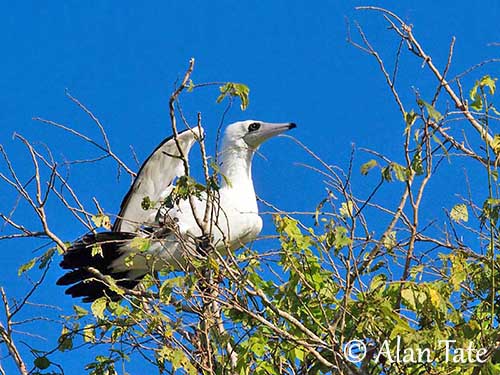
Text by Nicole Bouglouan
Photographers :
Didier Buysse
Vision d’Oiseaux
Alfredo Colón
Puerto Rico Wildlife
Jean Michel Fenerole
Photos d’Oiseaux du monde
Ken Havard
My Bird Gallery & Flickr gallery 1 & Flickr gallery 2
Steve Garvie
RAINBIRDER Photo galleries
Tom Grey
Tom Grey's Bird Pictures
Paul Guillet
Photos d’Oiseaux
Patrick Ingremeau
TAMANDUA
René Lortie :
http://rlortie.ca/
Tom Merigan
Tom Merigan’s Photo Galleries
Dubi Shapiro
Dubi Shapiro Photo Galleries & Dubi Shapiro Bird's images
Alan & Ann Tate
AA Bird Photography
Nicole Bouglouan
PHOTOGRAPHIC RAMBLE
Sources :
HANDBOOK OF THE BIRDS OF THE WORLD vol 1 by Josep del Hoyo-Andrew Elliot-Jordi Sargatal - Lynx Edicions - ISBN: 8487334105
L’ENCYCLOPEDIE MONDIALE DES OISEAUX - Dr Christopher M. Perrins - BORDAS - ISBN: 2040185607
THE HANDBOOK OF BIRD IDENTIFICATION FOR EUROPE AND THE WESTERN PALEARCTIC by Mark Beaman, Steve Madge - C.Helm - ISBN: 0713639601
A Field Guide to the Birds of South-East Asia by Craig Robson. New Holland Publishers. ISBN: 9781780090498
BirdLife International (BirdLife International)
Wikipedia, the free encyclopaedia
XENO-CANTO – Sharing Birds sounds from around the world
CREAGUS@Monterey Bay (Don Roberson)
FAMILY SULIDAE
Gannets and Boobies of genus Papasula, Sula and Morus
The Family Sulidae includes three genera in order to classify these beautiful seabirds. All are strictly marine, spending long periods away from land. They usually breed on offshore islets and islands where they establish their dense colonies. They feed on fish, using typical and spectacular feeding behaviour. They are good fliers, performing powerful and agile flight, and diving abruptly into the sea for preys. Very elegant and graceful when displaying, gannets and boobies may become aggressive against the neighbours while defending their nest-site. However, they are gregarious all year round, fishing and living in flocks.
It could be honest to start with the most ancient species, the Abbott’s Booby (Papasula abbotti), which is the only member of this genus, and probably the most primitive Sulidae, coming from different lineage.
This species is listed as Endangered, with small populations and reduced range in Christmas Island. In addition, the quality of its habitat is still declining.
The Abbott’s Booby has black and white plumage, with white body, dark spots on flanks, and blackish wings and tail. With a length on 80 cm and a weight of about 1500 grams, it could be very similar to other Sulidae species. But it differs by its behaviour and the bill shape. Contrary to other boobies, it has a slightly hooked bill and highly serrated cutting edges.
The female has pinkish bill whereas that of male is blue-grey tinged pinkish.
The juvenile resembles adult in worn plumage, but its bill is grey.

This species is strictly marine and pelagic. It feeds on squid and flying-fish probably caught by plunge-diving, as other boobies. It usually performs long foraging trips in order to find abundant food resources, and may be away from the nest for some days.
The Abbott’s Booby gives loud, raucous calls.
Abbott's Booby's voice by Xeno-Canto
Unlike other Sulidae species which often nest on the ground and in colonies, the Abbott’s Booby nests fairly solitary or in small loose colonies of less than ten pairs / ha. The nest is a rough stick platform in tree-top in the rainforest.
The female lays a single egg between May and July, and both sexes incubate during 57 days. The chick is covered in white down. It is fed by both parents and fledges about 140-175 days after hatching, but it still depends on adults for several weeks more. It can breed at 4-6 years.
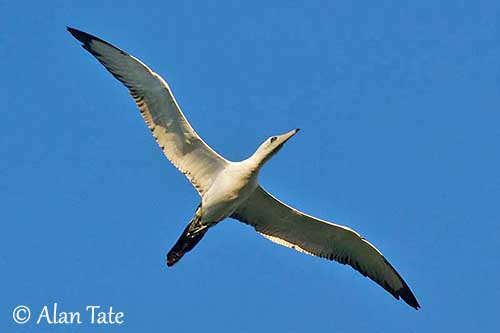
Abbott’s Booby’s movements are poorly known. Adults are probably sedentary, except the long foraging trips. However, young birds and non-breeders leave Christmas Island, maybe moving to S of Java.
Several measures are in progress or yet active in order to protect this species. It breeds in a National Park on Christmas Island and the main goal is to maintain the current survival populations.
BOOBIES OF GENUS SULA
Boobies of genus Sula are slightly different from each other by size and plumage pattern. All have the typical cigar-shaped robust body and wedge-shaped tail. Females are usually larger and heavier than males.
All have long, stout and conical bill, with serrated cutting edges easier for catching fish. But Abbott’s Booby is the only one having slightly hooked bill tip. Nostrils are adapted to plunge-diving, and are covered when the bird enters the water.
We can see more or less extensive bare facial skin according to the species. These parts can be brighter when the breeding season starts, and are enhanced by displays especially in Red-footed Booby (Sula sula) and Blue-footed Booby (Sula nebouxii) which have bright coloured legs and feet which are particularly important in ritualized displays.
Boobies have very good binocular vision thanks to the eyes placed beside the bill. Iris is often pale-coloured (but not always), giving these birds a peculiar and beautiful aspect.
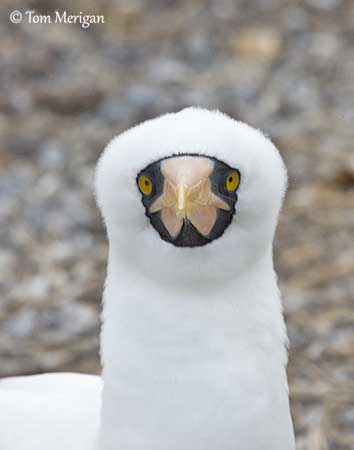
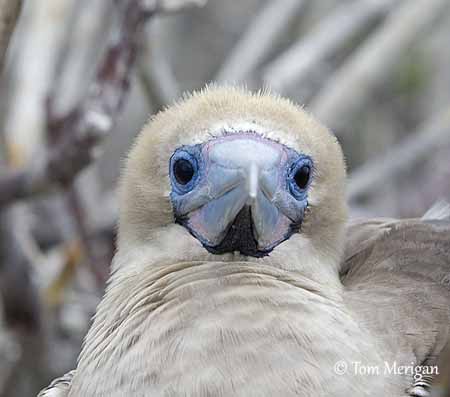
The long, narrow, pointed wings make the flight powerful in strong winds, but are especially adapted to the highly specialized fishing behaviour. The birds may glide low over the waves, but usually, they perform powerful wingbeats interspersed with glides.
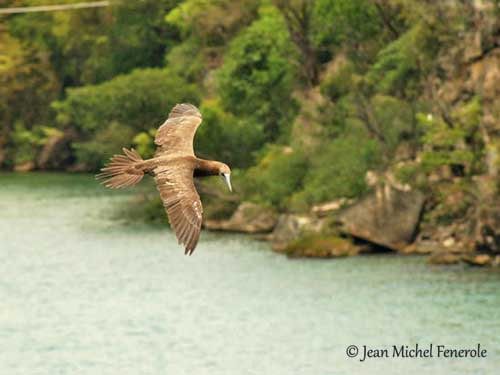
Brown Booby - Juvenile
Sula leucogaster
These graceful birds are clumsy on the ground. However, their completely webbed feet typical of Pelecaniformes allow them to swim well, even in roughest seas. They are also used for incubation because they lack brood patches.
The white underparts make them invisible to their preys from underwater. Except the Brown Booby (Sula leucogaster) and the brown form of the Red-footed Booby, all adults have white underparts and dark primaries in all plumages.
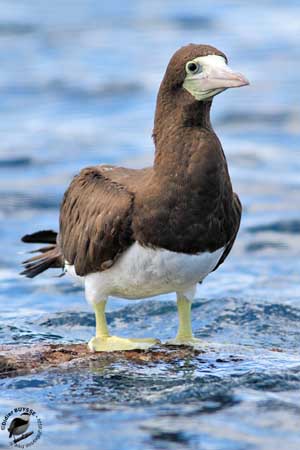
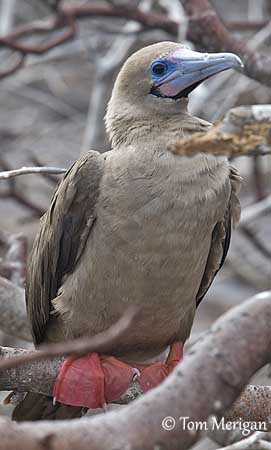
Brown Booby - Sula leucogaster
Juveniles tend to be dark brown first, and this colour protects them against the aggressive white gulls which could attack or kill them as adult-looking birds. The exception if the Abbott’s Booby juvenile which is similar to parents in worn plumage. They will gain the adult plumage through several mottled phases in five or six years, at the same time as sexual maturity.
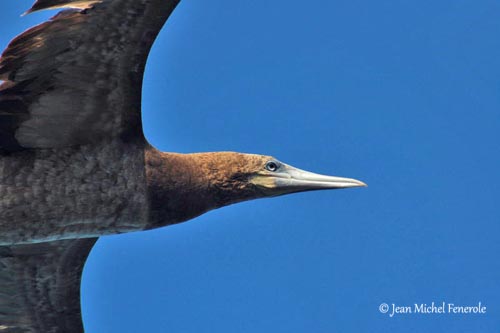
Brown Booby - juvenile
Sula leucogaster
These aerial birds moult more or less continuously, because they feed by plunge-diving, and they need to fly all year round to survive. This spectacular behaviour is a peculiar feature of Sulidae species. The birds may dive from variable heights and penetrate into the water to moderate depths, where the large shoals of fish and squid are moving.
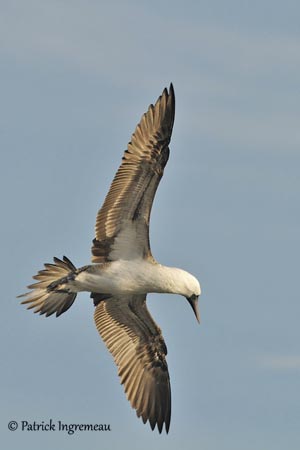
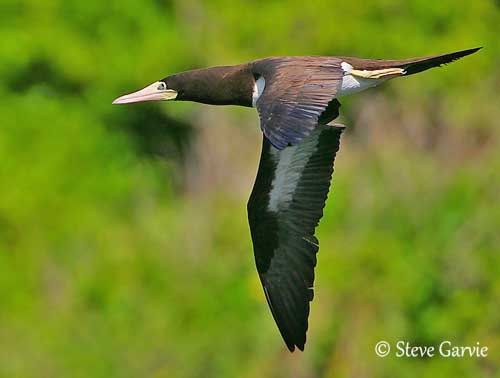
They take advantage of their binocular vision to fly higher than other seabirds, and can more easily locate the preys. They usually dive from about 20-30 metres, sometimes more. Masked Booby (Sula dactylatra) and very similar Nazca Booby (Sula granti) may dive from 100 metres up. They dive at an angle and in relatively shallow waters. Once underwater, they catch the fish or the squid when they are rising again towards the surface. The prey is often swallowed underwater, in order to avoid piracy from other seabirds.
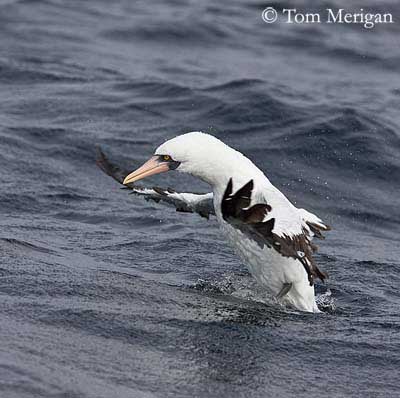
Sula granti
Some species perform surface-dive for feeding, or pursue the preys underwater by swimming and even forage on foot in shallow water. This is the case of several boobies. The Red-footed Booby is able to catch preys such as flying fish while flying. Squid are often taken from the surface.
They often follow the trawlers where fish aggregations are common.
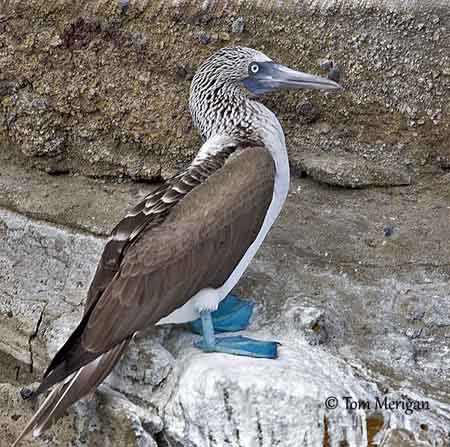
Sula nebouxii
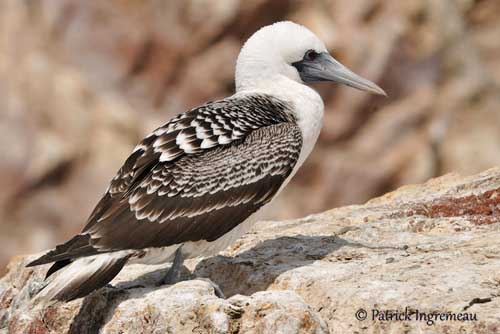
Sula variegata
BREEDING AND NESTING BEHAVIOUR
Boobies of genus Sula are not highly seasonal for breeding, adapting the laying to food resources and weather conditions. But Abbott’s Booby and Peruvian Booby usually breed in the same season every year.
They form colonies, from huge and large to small ones, and density varies with the type of ground and habitat. Social behaviour and displays play an important part in these agglomerations of birds. They are used to establish the territory and defend the nest-site, involving boundary disputes with neighbours.
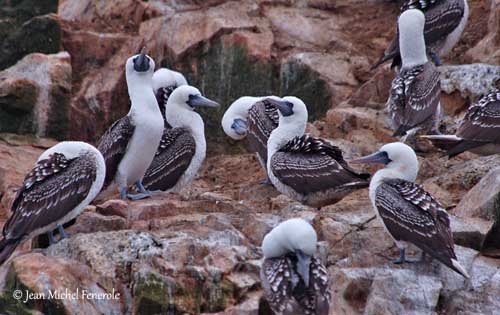
Sula variegata
Boobies frequently use wings and feet during displays. The Blue-footed Booby performs “foot-rocking” which enhances the bright-coloured webbed feet while the male stretches them forwards in front of its mate.
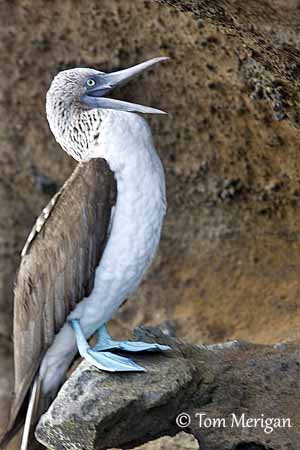
Sula nebouxii
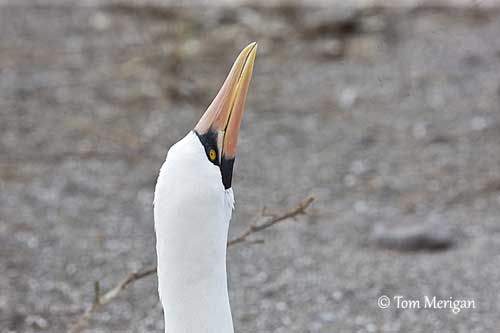
Sula granti
Several other displays are performed according to the moment and the situation. Courtship feeding is very occasional in Sulidae species, but it can be reported for some of them.
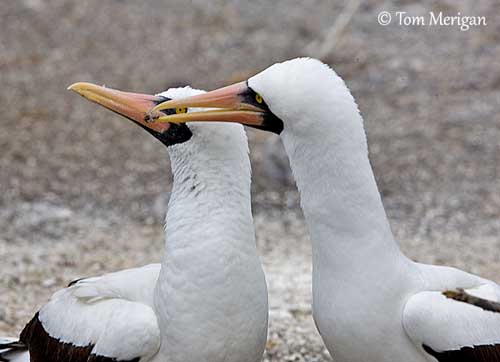
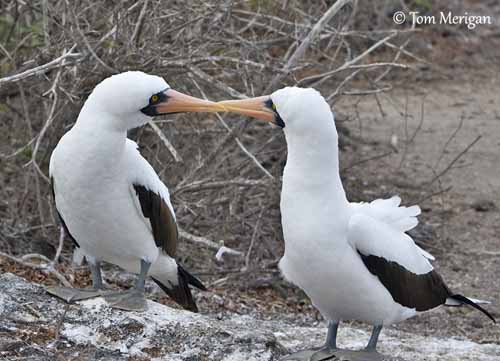
Sula granti
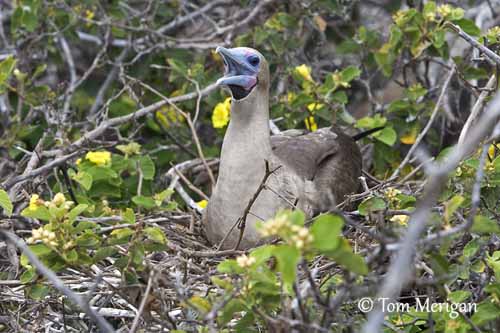
Masked Booby and Nazca Booby nest on flat ground or on slope or cliff, and the nest is a rounded mound of excreta, the famous guano. Blue-footed Booby and Brown Booby nest on the ground but often in vegetation, whereas the Peruvian Booby makes a loose pile of seaweeds stuck by droppings, or no nest at all.
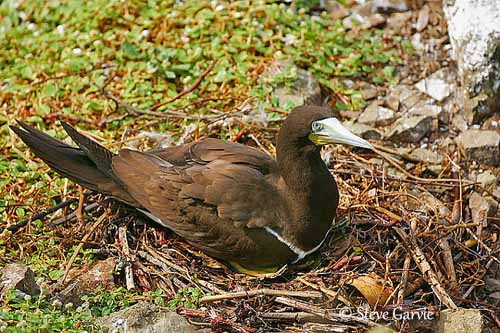
Sula leucogaster
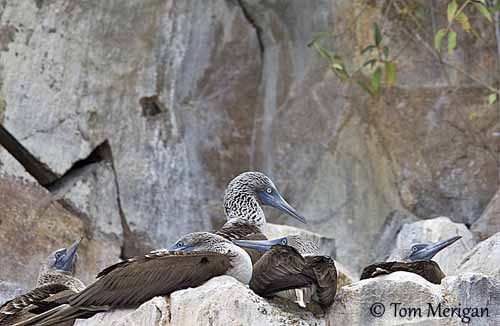
Sula nebouxii
The clutch size depends on food resources. Species nesting close to abundant food sources such as Peruvian Booby and Blue-footed Booby may have two or three eggs. Brown Booby Nazca Booby and Masked Booby often have two eggs, but even if both hatch, only one chick will be reared by adults. The other boobies lay a single egg.
Eggs are pale-coloured blue, green or white with a chalky layer. During incubation, they usually become darker, even brown or black.
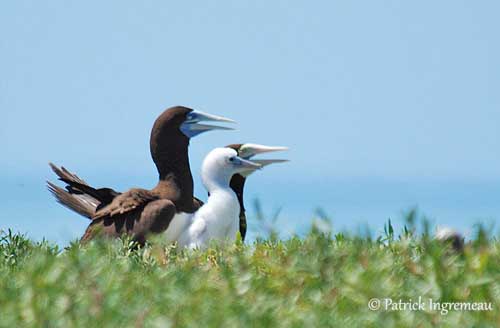
Sula leucogaster
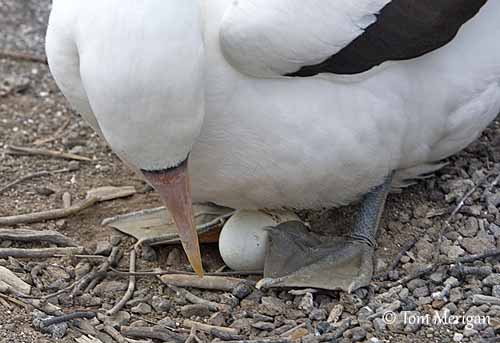
Sula granti
Parents incubate and keep the eggs warm with their webbed feet. All Sulidae species lack brood patch, and apply the large webs of the feet to the egg(s). Fortunately, eggs have thick shell and adults actually stand on the eggs.
Incubation lasts about 40-45 days except Abbott’s Booby with 57 days, during which nest and eggs are exposed to predators and bad weather.
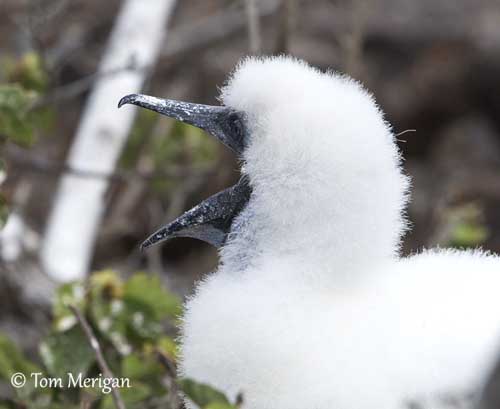
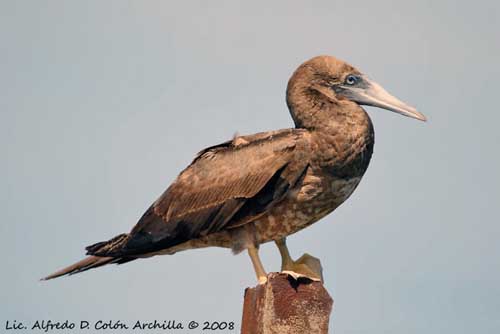
Sulidae species start to breed between two and six years old. They are long-lived birds, between ten and twenty years, sometimes more, up to forty. Mortality is high during the first year of the young’s life, and males suffer higher mortality than females, probably due to more fighting and displaying, defence of the nest-site and collecting nest-materials, that involve more risk for them.
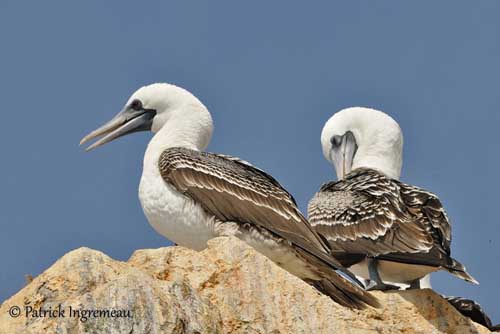
Sula variegata
Boobies are usually silent at sea, but at colonies, female and young utter harsh grunts and honks, whereas male gives thin whistles.
Sounds by Xeno Canto

Sula granti
They swim in buoyant manner on water, and need to patter over the surface to take off. They have strong and direct flight with deep wingbeats interspersed with glides. Flocks fly in long lines. They glide and turn in unison.
Adults often remain in the close vicinity of colonies, whereas young birds disperse widely after the breeding season.
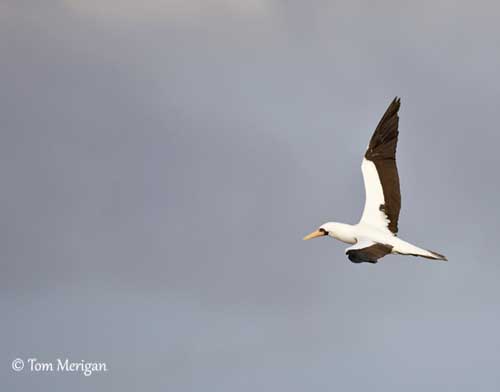
Sula granti
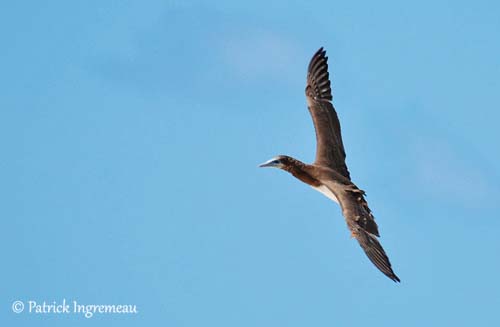
Sula leucogaster
GANNETS OF GENUS MORUS
The genus Morus gathers only three species, Northern Gannet (Morus bassanus) from both sides of Atlantic, Cape Gannet (Morus capensis) from coasts of South Africa, and Australasian Gannet (Morus serrator) from coasts of SE Australia, Tasmania and New Zealand.
These birds are fairly different from boobies. They have pure white body and neck, black parts on wings and tail, and buffy-yellow head. They differ from each other by black patches extent on flight feathers and rectrices, intensity of head colour, and length of the black gular stripe. All have the stout conical bill of Sulidae species, here pale blue-grey bordered black at base and on lores. The eyes are pale bluish-white surrounded by more or less bright blue eyering. Legs and webbed feet are blackish with pale greenish toes.
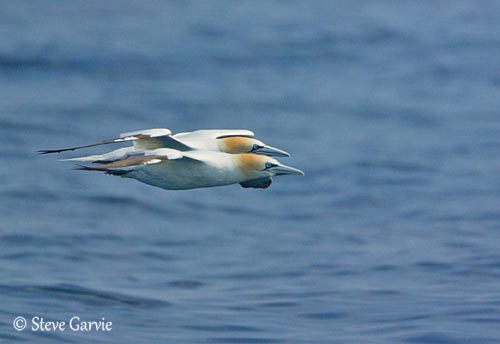
Morus bassanus
Gannets are larger and heavier than boobies with length between 84 and 100 cm, and weight between 2300 and 3600 grams. The Northern Gannet is the largest of all species.
Both sexes are similar. At hatching, chicks are almost naked, but they rapidly gain white down on blackish skin.
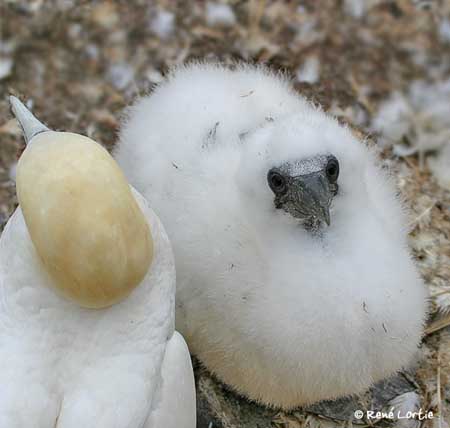
Morus bassanus
They are similar to boobies in almost all behaviours, but with some differences.
The large size usually requires a short run over the water surface before to take-off, but they are powerful fliers.
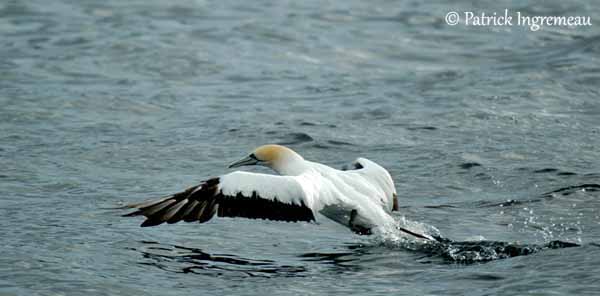
Morus serrator
The Cape Gannet which nests on flat ground uses a kind of “runway” to gain the necessary lift for take-off. The wind is a good help for this species, and it has to wait if weather conditions are too calm.
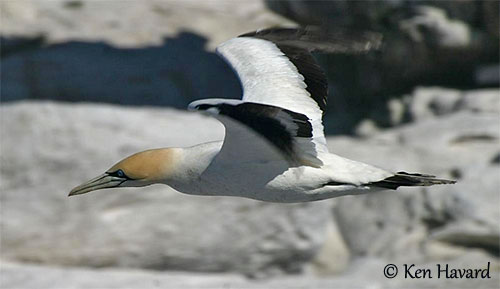
Morus capensis
Unlike boobies, gannets have immaculate plumage overall, except wings and tail. The contrast against the blue of the sea is important, and may be useful for other gannets as indicator of food. Gannets performing their spectacular plunge-diving may inform that an important food source has been found.
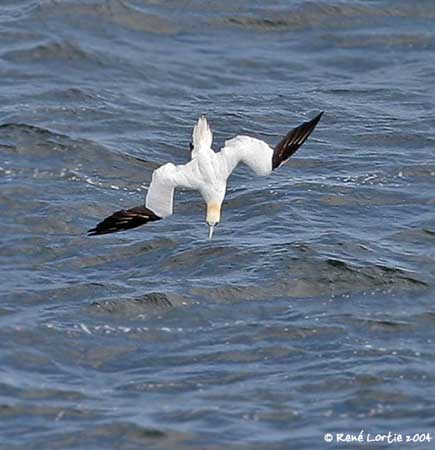
Morus bassanus
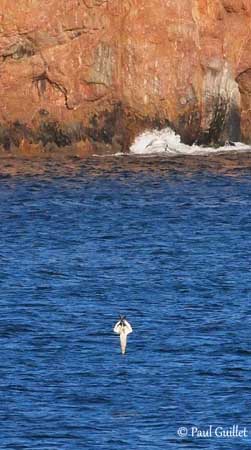
Morus bassanus
The shoals of mackerel, pilchard and anchovy are their commonest food. They forage high in the air, and thanks to their binocular vision, they can select a particular prey among numerous other items. They plunge-dive from 10-30 metres up, and sometimes more.
Gannets which are more heavily built dive vertically and from greater height than boobies. Once a prey is selected, the gannet appears to stall, maybe to adjust the direction before diving and entering the water at top speed. Wings are pushed backwards, parallel to the body.
The Northern Gannet, the heaviest of all, may reach depths of about 10 metres only with the impulse of the dive. It may use its wings to penetrate deeper, up to 15 metres, and occasionally 25 metres. It catches the fish when it is on its way up, and the prey is usually swallowed underwater. This behaviour allows the gannet to avoid piracy from other seabirds.
Gannets often feed in groups and plunge-dive in as one.
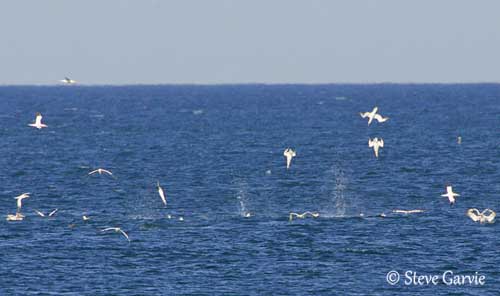
Morus bassanus
Gannets usually lay regularly in the same season every year, and breeding density is high. They nest in large colonies, except the Australasian Gannet which prefers rather small but dense colonies.
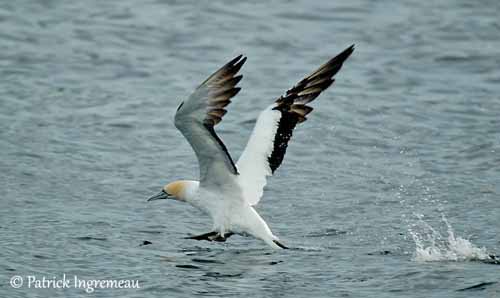
Morus serrator
The Northern Gannet nests on steep cliffs, with the danger of falling. For this reason, they avoid strong physical fight, preferring ritualized postures, both threat and appeasement, to sort out territorial conflicts.
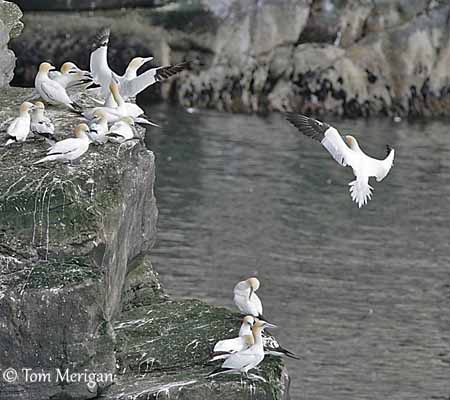
Morus bassanus
The Cape Gannet nests on flat ground on offshore islands, in dense colonies with nest very close to each other. So, aggressive squabbles can be frequent and quite violent.
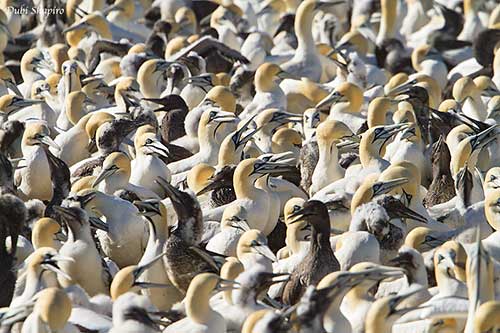
Cape Gannet - Morus capensis - Colony
These aggressive encounters are less frequent in the smaller colonies of the Australasian Gannet. However, males of this species are fairly violent when mating while biting strongly the nape of the female.
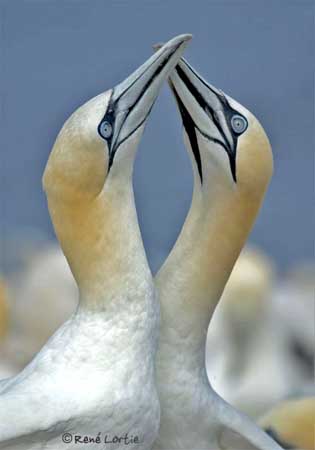
Displays are fairly similar to that of boobies too, maybe more ritualized, with very complex stereotyped behaviour.
They communicate by “headshake”, the bill may become a threat, the neck is stretched in “sky-pointing”, and bowing and greeting ceremonies occur too.
Morus bassanus
The nests are made with grass and seaweeds, or debris, stuck together with excreta. Gannets lay a single egg, rarely two. Both parents incubate with their webbed feet during 44 days. The chick fledges between 90 and 100 days after hatching. It is fed by both adults. They can breed at about 4-6 years of age.
They are long-lived birds, as boobies.
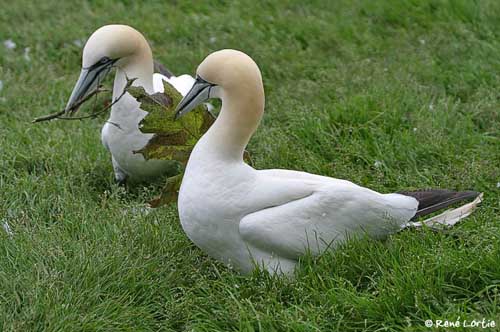
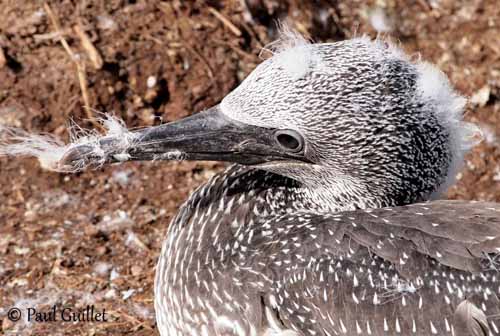
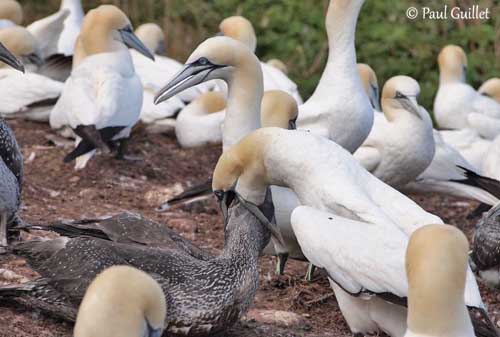
Gannets have loud, raucous voices, and male and female produce similar sounds. They utter series of harsh calls when fishing, rasping calls when arriving at nest, low grunts and plaintive calls during displays.
Sounds by Xeno-Canto
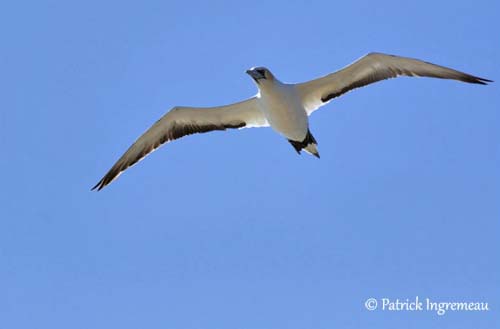
Morus serrator
Their flight is powerful and direct. Series of strong wingbeats are interspersed with short glides. The long, narrow, pointed wings are very well adapted for cruising along in strong winds.
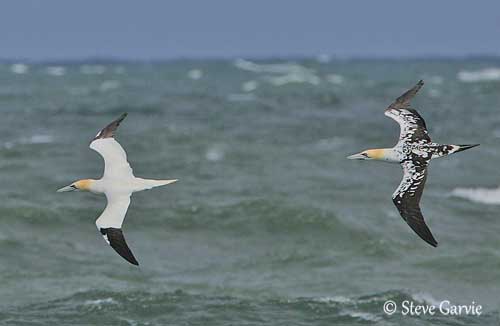
Except the rare Abbott’s Booby which is listed Endangered, and the Cape Gannet listed as Vulnerable, other gannets and boobies are not globally threatened.
Formerly, persecuted by human and local people, they were disturbed at colonies by exploitation of guano and egg-collecting, and even killing of adults. Introduced predators are still an important threat for these ground-nesting birds.
Weather conditions may disturb as well the nidification with storms destroying the nests or killing the chicks, as feeding behaviour by El Niño along the Peruvian coasts, involving the lack of food. Overfishing reduces the fish resources for long time. Tourism development, especially in the tropics, involves destruction of breeding habitat. Oil pollution and debris at sea are true threats for these birds.
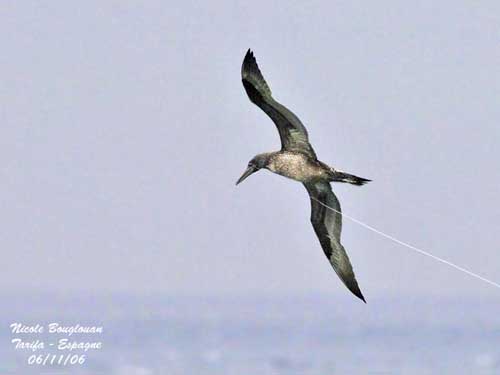
However, colonies are dense in most parts of the distribution in spite of reduced breeding range.
Abbott’s Booby is now protected in National Park on Christmas Island. Human persecutions with exploitation of guano and eggs have decreased, involving the slow recovery of populations.
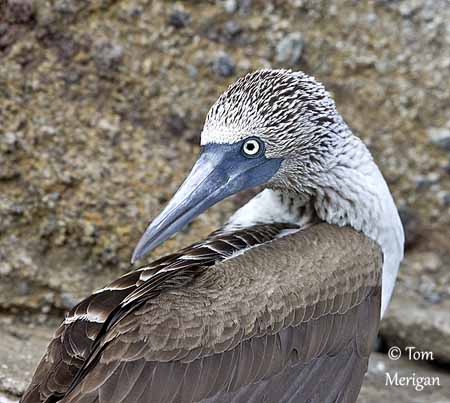
Sula nebouxii
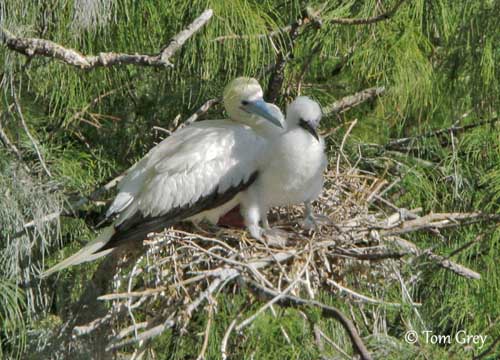
These birds are named “gannet” and “booby” in English, and “fou” in French (meaning “crazy”). Why???
The word “gannet” comes from both Old English “gans” (meaning “a goose”) and traditional Scottish name of the Northern Gannet “solan goose”, and the Gaelic name “sula” which was the first scientific name of the genus.
The word “booby” (meaning “stupid”) refers to their lack of fear of humans, making then easy to catch.
In French, the word “fou” (meaning “crazy”) could refer to the spectacular fishing behaviour of these birds, coming from nowhere in the sky and disappearing abruptly into the sea.
Anyway, fou, gannet and booby are handsome birds, traditionally the object of man’s admiration. The Northern Gannet is the symbol of marriage between wind and sea for numerous poets.
We must protect them through several conservation measures. Sea coasts would be sad without their conspicuous presence.
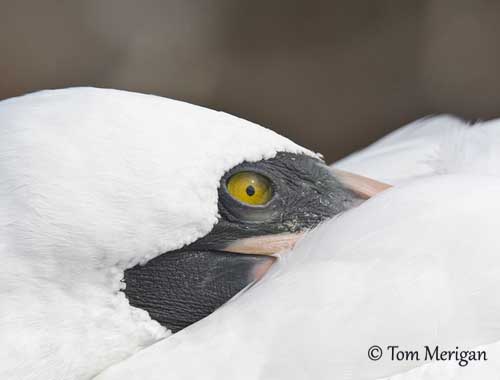
Sula granti
Papasula abbotti
Papasula abbotti